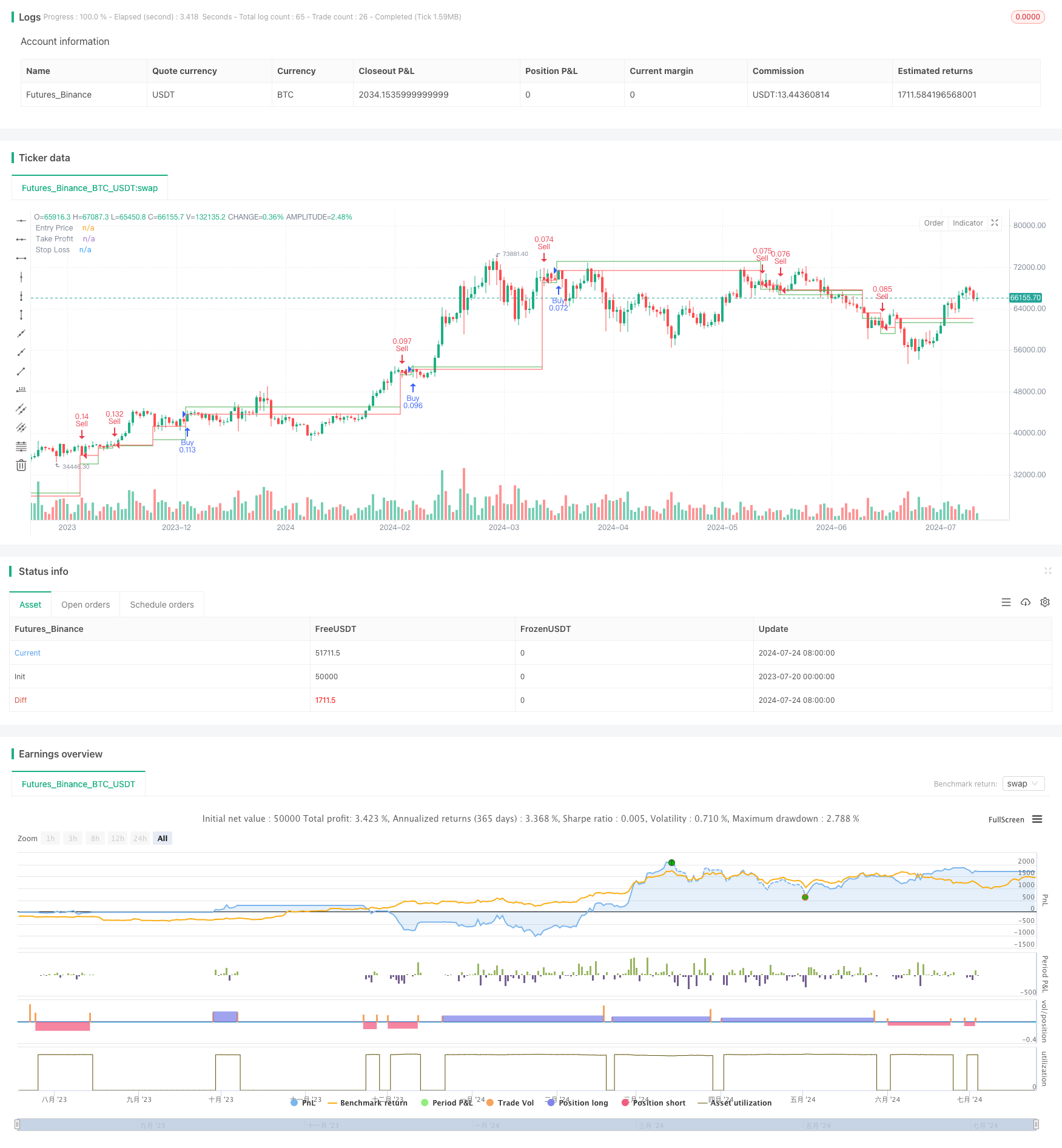
概述
本文将介绍一种基于4小时时间框架的吞没形态交易策略,该策略结合了动态止盈和固定点数止损机制。这种策略利用吞没形态这一强大的价格行为信号来识别潜在的趋势反转,并通过设置动态的获利目标和固定的止损点来管理风险和优化收益。该策略适用于各种金融市场,包括股票、外汇和加密货币等。
策略原理
该策略的核心原理是识别4小时图表上的看涨和看跌吞没形态。吞没形态是一种由两根蜡烛线组成的价格模式,其中第二根蜡烛线的实体完全”吞没”了前一根蜡烛线的实体。这种形态通常被视为潜在的趋势反转信号。
具体来说,策略的运作原理如下:
看涨吞没形态:当当前收盘价高于前一根蜡烛线的开盘价,且当前开盘价低于前一根蜡烛线的收盘价时,形成看涨吞没形态。此时,策略会开立多头头寸。
看跌吞没形态:当当前收盘价低于前一根蜡烛线的开盘价,且当前开盘价高于前一根蜡烛线的收盘价时,形成看跌吞没形态。此时,策略会开立空头头寸。
动态止盈:策略使用吞没蜡烛线的实体大小乘以一个可调整的乘数来设置获利目标。这种方法允许根据市场波动性动态调整获利目标。
固定点数止损:策略使用固定数量的点数来设置止损,这有助于限制每笔交易的最大损失。
头寸规模:策略默认使用账户权益的10%作为每笔交易的头寸大小,这有助于实现有效的资金管理。
策略优势
可靠的入场信号:吞没形态是一种广受认可的价格行为模式,通常能够提供相对可靠的趋势反转信号。在4小时时间框架上使用这种形态可以过滤掉较小时间框架上的噪音。
动态止盈机制:通过使用吞没蜡烛线的实体大小来设置获利目标,策略能够根据当前市场波动性自动调整目标。这种方法有助于在波动性较大时获得更大的利润,同时在波动性较小时保护已有盈利。
风险管理:固定点数止损机制为每笔交易提供了明确的风险限制,有助于防止大幅度的亏损。
适应性强:策略可以应用于多种金融市场和交易品种,具有广泛的适用性。
简单而有效:策略逻辑相对简单,易于理解和实施,同时又能捕捉重要的市场转折点。
可定制性:策略提供了多个可调整的参数,如止盈乘数和止损点数,使交易者可以根据自己的风险偏好和交易风格进行优化。
策略风险
假突破风险:吞没形态有时可能产生假信号,特别是在横盘市场或者高波动性环境下。这可能导致不必要的交易和潜在的亏损。
过度交易:在某些市场条件下,策略可能生成过多的交易信号,增加交易成本并可能导致过度交易。
滑点风险:在快速变动的市场中,实际的入场和出场价格可能与预期存在差异,影响策略的整体表现。
固定止损的局限性:虽然固定点数止损提供了明确的风险控制,但可能不适合所有市场条件,特别是在波动性剧烈变化的时期。
依赖单一指标:策略主要依赖吞没形态这一单一指标,可能忽视其他重要的市场信息和指标。
参数敏感性:策略的表现可能对止盈乘数和止损点数等参数的设置非常敏感,需要仔细优化和回测。
策略优化方向
引入额外的过滤条件:可以考虑结合其他技术指标,如趋势指标(如移动平均线)或动量指标(如相对强弱指数RSI),以确认吞没形态的有效性,减少假信号。
动态止损机制:可以考虑使用ATR(平均真实范围)指标来设置动态止损,使止损更好地适应当前市场波动性。
时间过滤:可以添加时间过滤器,避免在市场波动性较低的时段(如亚洲盘)开仓,从而减少假突破的风险。
市场状态识别:引入算法来识别当前市场是趋势市还是震荡市,并相应地调整策略参数或暂停交易。
头寸管理优化:可以实现更复杂的头寸管理策略,如根据账户余额、当前波动性或胜率动态调整头寸大小。
多时间框架分析:结合更长和更短的时间框架来确认趋势和入场点,提高策略的稳健性。
机器学习优化:使用机器学习算法来优化策略参数,或者预测吞没形态的成功率。
相关性分析:在多个交易品种上同时运行策略时,考虑品种间的相关性,以更好地分散风险。
总结
4小时时间框架上的吞没形态交易策略结合了动态止盈和固定点数止损,为交易者提供了一个简单而有效的市场参与方法。该策略利用吞没形态这一经典的价格行为模式来识别潜在的趋势反转,并通过动态止盈机制来适应市场波动性的变化。固定点数止损则为每笔交易提供了明确的风险控制。
虽然策略具有多项优势,如可靠的入场信号、动态止盈和明确的风险管理,但也存在一些潜在的风险,如假突破和过度依赖单一指标等。为了进一步提高策略的稳健性和性能,可以考虑引入额外的过滤条件、实现动态止损、进行多时间框架分析等优化方向。
总的来说,这个策略为交易者提供了一个良好的起点,可以根据个人交易风格和风险偏好进行进一步的定制和优化。通过仔细的参数调整、充分的回测和实盘验证,该策略有潜力成为一个可靠的交易系统的重要组成部分。然而,交易者应始终牢记市场的不可预测性,并结合其他分析方法和风险管理技术来补充这一策略。
/*backtest
start: 2023-07-20 00:00:00
end: 2024-07-25 00:00:00
period: 1d
basePeriod: 1h
exchanges: [{"eid":"Futures_Binance","currency":"BTC_USDT"}]
*/
//@version=5
strategy("4H Engulfing Candle Strategy", overlay=true, default_qty_type=strategy.percent_of_equity, default_qty_value=10)
// Input variables
tpMultiplier = input.float(1.0, "Take Profit Multiplier", step=0.1)
slTicks = input.int(100, "Stop Loss Ticks") // Number of ticks for SL
// Calculate body size for bullish and bearish engulfing candles on 4H timeframe
bullishBodySize = close - open
bearishBodySize = open - close
// Determine engulfing conditions on 4H timeframe
bullishEngulfing = close > open[1] and open < close[1] and open <= open[1] and close >= close[1]
bearishEngulfing = close < open[1] and open > close[1] and open >= open[1] and close <= close[1]
// Entry and exit levels
var float entryPrice = na
var float tpPrice = na
var float slPrice = na
if bullishEngulfing
entryPrice := close
tpPrice := close + bullishBodySize * tpMultiplier
slPrice := entryPrice - slTicks * syminfo.mintick // Calculate SL price based on ticks and tick size
// Execute strategy orders for bullish engulfing
strategy.entry("Buy", strategy.long)
strategy.exit("TP/SL", "Buy", limit=tpPrice, stop=slPrice)
if bearishEngulfing
entryPrice := close
tpPrice := close - bearishBodySize * tpMultiplier
slPrice := entryPrice + slTicks * syminfo.mintick // Calculate SL price based on ticks and tick size
// Execute strategy orders for bearish engulfing
strategy.entry("Sell", strategy.short)
strategy.exit("TP/SL", "Sell", limit=tpPrice, stop=slPrice)
// Plot entry, take profit and stop loss levels
plot(entryPrice, color=color.new(color.green, 0), style=plot.style_stepline, title="Entry Price")
plot(tpPrice, color=color.new(color.green, 0), style=plot.style_stepline, title="Take Profit")
plot(slPrice, color=color.new(color.red, 0), style=plot.style_stepline, title="Stop Loss")